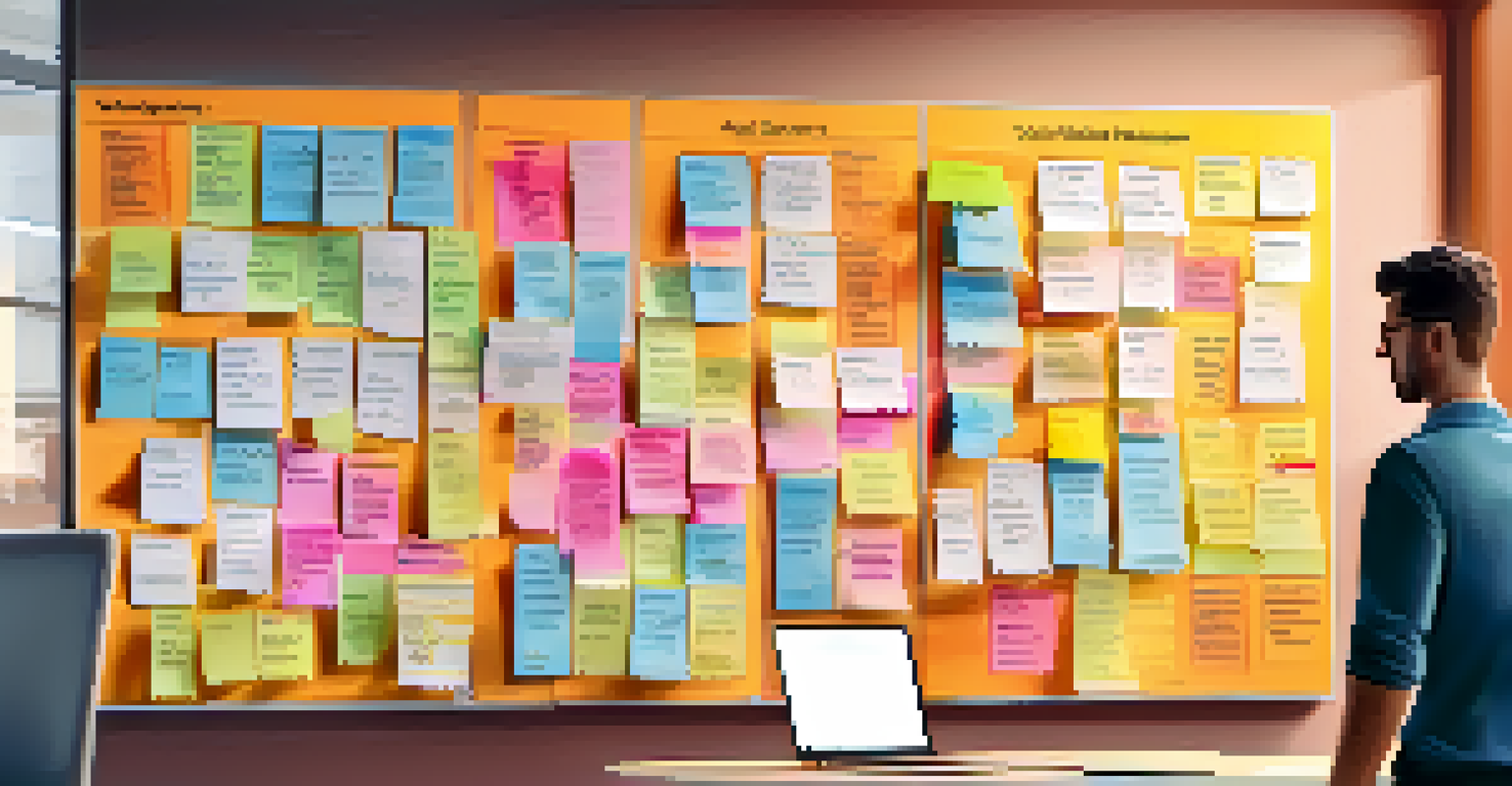Utilizing Agile Methodologies for Remote Team Management

Understanding Agile Methodologies in a Remote Context
Agile methodologies are all about adaptability and responsiveness, making them ideal for remote teams. At its core, Agile focuses on iterative development, allowing teams to evolve their work based on feedback and changing requirements. This is particularly important in a remote setting where team dynamics and project scopes can shift rapidly due to external factors.
Agile is not a destination; it’s a journey of continuous improvement.
By embracing Agile, remote teams can break down complex projects into smaller, manageable tasks, often referred to as sprints. This not only keeps the team aligned but also fosters a sense of accomplishment as they complete each sprint. Think of it like climbing a mountain: instead of tackling the whole peak at once, you take it step by step, enjoying the view along the way.
Incorporating Agile principles helps remote teams stay cohesive despite physical distances. Regular check-ins and feedback loops can enhance communication, ensuring everyone is on the same page and moving towards shared goals.
Building a Collaborative Remote Team Culture
A strong collaborative culture is vital for remote teams to thrive under Agile methodologies. This means creating an environment where team members feel comfortable sharing ideas, asking questions, and providing feedback. Simple practices like virtual team-building activities can go a long way in fostering camaraderie among remote workers.

Establishing clear communication channels is essential for collaboration. Tools like Slack or Microsoft Teams provide platforms for real-time communication, allowing team members to discuss projects, share updates, and celebrate wins quickly. It’s like having a virtual water cooler where everyone can gather, even if they’re miles apart.
Agile Enhances Remote Team Dynamics
Agile methodologies promote adaptability and collaboration, making them ideal for managing remote teams effectively.
Encouraging a culture of openness and trust can significantly enhance team dynamics. When team members feel valued and heard, they’re more likely to contribute actively, leading to innovative solutions and a more engaged workforce.
Setting Clear Goals and Expectations
In an Agile environment, setting clear goals and expectations is crucial for remote teams. This involves defining the project’s scope, deadlines, and individual responsibilities right from the outset. When everyone knows what’s expected, it helps to reduce confusion and align efforts toward a common objective.
The strength of the team is each individual member. The strength of each member is the team.
Using frameworks like SMART goals—Specific, Measurable, Achievable, Relevant, Time-bound—can provide clarity for team members. For instance, instead of saying, 'Finish the project soon,' a SMART goal would be, 'Complete the first phase of the project by the end of the week.' This specificity helps remote teams to stay focused and accountable.
Regularly revisiting these goals during Agile ceremonies, such as retrospectives, ensures that everyone is still aligned and can adjust as needed. This adaptability is a hallmark of Agile, enabling teams to pivot effectively in response to new insights or challenges.
Effective Communication Tools for Remote Teams
Selecting the right communication tools is essential for remote teams utilizing Agile methodologies. Tools like Trello or Jira can help manage tasks and track progress, while Zoom or Google Meet can facilitate face-to-face interactions. Choosing the right mix of tools can make collaboration seamless, even from a distance.
Moreover, it's important to establish guidelines for communication. For example, deciding when to use chat for quick questions versus scheduling a video call for more in-depth discussions can enhance efficiency. Think of it as having the right tool for the job—using a hammer for nails and a screwdriver for screws.
Clear Goals Drive Team Success
Setting clear goals and expectations ensures that remote team members stay aligned and focused on common objectives.
Effective communication also extends to how feedback is delivered. Constructive feedback should be timely and encouraging, fostering an environment where team members feel empowered to improve continuously.
Implementing Agile Ceremonies in a Remote Setting
Agile ceremonies, such as daily stand-ups and sprint reviews, play a pivotal role in keeping remote teams aligned. Daily stand-ups, even if virtual, allow team members to share updates and challenges, promoting accountability and collaboration. Imagine it as a morning huddle where everyone shares their game plan for the day.
Sprint reviews provide an opportunity to showcase completed work and gather feedback from stakeholders. This not only validates the team's efforts but also encourages a sense of ownership and pride. Engaging stakeholders in these reviews can also strengthen relationships and ensure everyone's voice is heard.
Lastly, retrospectives are crucial for continuous improvement. In a remote setting, encouraging open discussions about what worked and what didn't can lead to valuable insights, helping teams evolve their processes for better results in future sprints.
Encouraging Continuous Learning and Adaptability
Agile methodologies emphasize the importance of continuous learning, which is even more critical for remote teams. Encouraging team members to pursue professional development opportunities, whether through online courses or workshops, can enhance their skills and overall team performance. It’s like planting seeds for future growth.
Creating a culture where mistakes are viewed as learning opportunities fosters adaptability. When team members feel safe to experiment and fail, it can lead to innovative solutions and improved processes. Consider it akin to a scientist in a lab—experimentation often leads to breakthroughs.
Celebrate Wins to Boost Morale
Recognizing achievements, no matter how small, fosters a culture of appreciation and keeps remote teams motivated.
Regularly reflecting on team performance and adapting strategies ensures that teams remain agile and responsive to change. This iterative approach not only enhances project outcomes but also keeps team members engaged and motivated.
Measuring Success and Celebrating Wins
Measuring success in an Agile framework involves tracking progress and celebrating achievements, no matter how small. Utilizing metrics, such as velocity or burn-down charts, can provide insights into team performance and project health. These visual indicators help teams stay focused and motivated.
Celebrating wins—whether it's completing a sprint or reaching a project milestone—can significantly boost morale. A simple shout-out during a team meeting or a virtual celebration can create a sense of accomplishment and unity among team members. It’s like throwing a mini-party for each milestone achieved.

By regularly measuring success and recognizing contributions, remote teams can maintain high levels of engagement and motivation. This not only reinforces positive behavior but also fosters a culture of appreciation, crucial for long-term success.